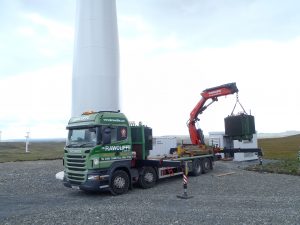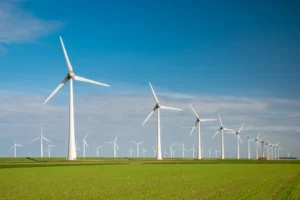With the need for renewable energy sources growing, the number of wind turbines is increasing every year.
But have you ever wondered how wind turbines are transported to wind farm sites?
Keep reading as we break down everything you need to know about wind turbine transportation.

What is a wind turbine?
A wind turbine is an excellent way to convert kinetic energy, in the form of wind, into electricity.
Turbines consist of three blades, which turn in the breeze, and create power using a generator. This is sometimes referred to as wind energy or wind power, and you can often spot them on land or in water.
Wind turbines are hugely popular as they’re a renewable source of energy, offering a more eco-friendly alternative to fossil fuels.
How do you transport a wind turbine to a wind farm site?
Wind turbines are often produced abroad and therefore require meticulously planned haulage.
On the road, they’re classified as heavy haulage, more specifically, abnormal load haulage.
What is abnormal haulage?
An abnormal load is often more than 2.9m wide or weighs more than 44,000kg. It also typically can’t be broken down into smaller pieces, or 2 or more loads without causing damage.
Wind turbines are so large and indivisible that they might not be able to fit on certain narrow roads or low bridges. Moving such huge machinery calls for careful planning, and you may even need to contact the authorities to ensure safety. It’s also essential that you comply with government rules and regulations.
Because of these unique factors, they can’t be transported using normal vehicles. This requires professional haulage fleets, specialised equipment, and experts.

How much does it cost?
Transporting such complicated freight can vary greatly in costs. Factors like distance, destination, the number of vehicles needed, the company you use, and what’s being transported can all affect the cost of haulage services.
Every project is different, so if you need a personalised quote, you can get in touch with the experts.
How big are turbine components?
Turbine components can massively differ in size, with wind turbine blades ranging anywhere from 0.5 to 15 metres long.
The average height of wind turbines and their separate components, like blades, is also increasing, which is projected to continue due to larger turbines generating much more energy. Because of this, size often varies on a case-by-case basis.

Why choose JB Rawcliffe when transporting wind turbines?
Here at JB Rawcliffe, we’re specialists in haulage services. Over the past 45 years, our projects have supported a range of industries including the construction, defence, marine, industrial, shipping, oil, and gas sectors.
We’re also proficient in a range of services across the UK, including abnormal load transport, heavy goods storage, machinery and cargo handling, and vehicle accident salvage and recovery.
Route planning when transporting such complex freight can be a minefield, which is why our team will take the reins on your project’s logistics, meticulously planning and fine-tuning every detail for you.
So, if you’re in need of friendly and professional haulage services from a knowledgeable team, get in touch with us today.
